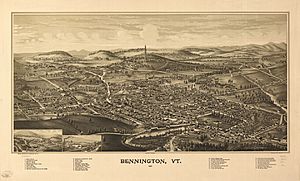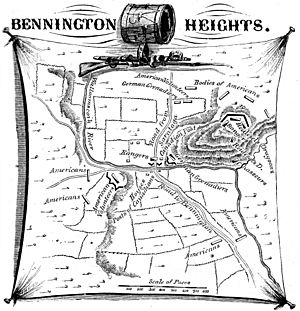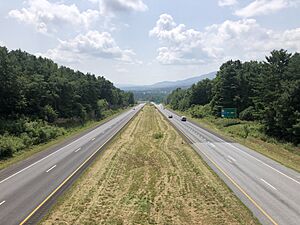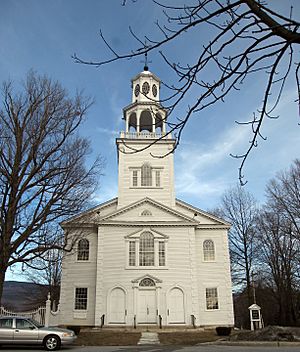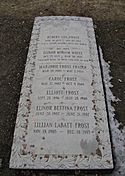Bennington, Vermont facts for kids
Quick facts for kids
Bennington, Vermont
|
|
|---|---|

|
|
| Motto(s):
It's Where Vermont Begins!
|
|
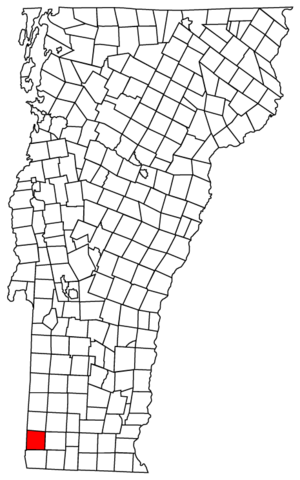
Located in Bennington County, Vermont
|
|
| Country | United States |
| State | Vermont |
| County | Bennington |
| Chartered | January 3, 1749 |
| Communities | Bennington North Bennington Old Bennington Paper Mill Village |
| Area | |
| • Total | 42.5 sq mi (110.1 km2) |
| • Land | 42.2 sq mi (109.4 km2) |
| • Water | 0.3 sq mi (0.7 km2) |
| Elevation | 817 ft (249 m) |
| Population
(2020)
|
|
| • Total | 15,333 |
| • Density | 360.69/sq mi (139.26/km2) |
| • Households | 6,246 |
| • Families | 3,716 |
| Time zone | UTC−5 (EST) |
| • Summer (DST) | UTC−4 (EDT) |
| ZIP Codes |
05201 (Bennington)
05257 (North Bennington) |
| Area code(s) | 802 |
| FIPS code | 50-04825 |
| GNIS feature ID | 1462039 |
Bennington is a busy town in Bennington County, Vermont, United States. It's one of two "shire towns" (or county seats) in the county. This means it's a main center for government and business. The other shire town is Manchester.
In 2020, about 15,333 people lived in Bennington. It is the biggest town in southern Vermont. It's also the second-largest town in all of Vermont, after Colchester. Bennington is the sixth-largest community in the state.
Bennington is famous for the Bennington Battle Monument. This monument is the tallest human-made structure in the state of Vermont. The town has a long history of making things, especially from wood. It is also well-known for its pottery, iron, and textiles (fabrics).
Contents
- Discovering Bennington's Past
- Bennington's Location and Landscape
- Who Lives in Bennington?
- Bennington's Economy and Jobs
- Learning in Bennington
- Getting Around Bennington
- Fun and Recreation in Bennington
- Bennington's Culture and Events
- Places to Visit in Bennington
- How Bennington Works: Utilities
- Famous People from Bennington
- See also
Discovering Bennington's Past
Bennington was the very first town to be officially started in the area known as the New Hampshire Grants. It was given its charter (official permission to exist) on January 3, 1749. Colonial Governor Benning Wentworth named the town after himself.
William Williams and 61 other people, mostly from Portsmouth, New Hampshire, were given the land. This makes Bennington the oldest town chartered in Vermont. However, Brattleboro was settled earlier as a fort. The first families moved to Bennington in 1761. They came from places like Hardwick and Amherst, Massachusetts. Captain Samuel Robinson led them. He had camped in the river valley after fighting in the French and Indian War.
Before European settlers arrived, the land belonged to the Western Abenaki people. They were part of the Wabanaki Confederacy. These native groups lived across much of what is now northern New England, southern Quebec, and the southern Canadian Maritimes.
Today, Bennington has three special historic areas. These are Old Bennington, Downtown Bennington, and North Bennington. Old Bennington was the first place settled in 1761. This is when a group of Congregational Separatists arrived. They came from Connecticut and parts of Massachusetts. By the early 1800s, Downtown Bennington began to grow. By 1854, the county's population had reached over 18,500 people.
The Famous Battle of Bennington
Bennington is especially famous for the Battle of Bennington. This important battle happened during the Revolutionary War. Even though the actual fighting was about 12 miles (19 km) away in what is now New York, a building in Bennington that stored ammunition was a key target.
On August 16, 1777, General John Stark led 1,500 soldiers from the New Hampshire Militia. They defeated 800 German soldiers, called Hessian mercenaries. These German fighters were working for the British. They were led by German Lieutenant Colonel Friedrich Baum. Local Loyalists, Canadians, and Native Americans also fought with them.
Later, more German soldiers arrived, led by Lieutenant Colonel Heinrich von Breymann. It looked like they might win. But then, Seth Warner's Green Mountain Boys arrived. These were the Vermont militia, first started by Ethan Allen. Their arrival helped turn the battle around.
In 1891, the Bennington Battle Monument was opened. This monument is a tall stone obelisk, about 306 feet (93 meters) high. It is the tallest human-made structure in Vermont. It is a popular place for tourists to visit.
Bennington's Location and Landscape
Bennington is found in the southwestern part of Bennington County. It is located at coordinates 42°53′28″N 73°12′29″W.
To the west of Bennington is New York State. To the south is the town of Pownal. Shaftsbury is to the north, and Woodford is to the east.
Bennington is in the very southwest corner of Vermont. It is actually closer to the capital cities of Albany, New York; Hartford, Connecticut; and Concord, New Hampshire than it is to Vermont's own capital, Montpelier.
The town covers a total area of about 42.5 square miles (110.1 square kilometers). Most of this is land (42.2 square miles or 109.4 square kilometers). Only a small part, about 0.3 square miles (0.7 square kilometers), is water. The Walloomsac River and its smaller streams flow through Bennington. These waters eventually join the Hoosic and then the Hudson River.
Bennington sits along the western edge of the Green Mountains. Bald Mountain is part of these mountains and is in the northeastern part of town. Its peak is just outside Bennington in Woodford. In the southwest, you'll find Mount Anthony, which is part of the Taconic Range.
Bennington's Weather and Seasons
Bennington has a humid continental climate. This means it has cold, snowy winters and warm, humid summers. The amount of snow can change a lot from year to year. Snow can fall as early as October and as late as April. The higher areas around town might even see snow in May.
Big winter storms, called Nor'easters, often bring heavy snow and strong winds. It's common to get a foot or more of snow during these storms. One time, on October 4, 1987, a very wet, heavy snow fell. Many people were surprised because it was so early in the fall. This storm caused many trees and power lines to fall because the leaves were still on the trees.
Summers in Bennington often have lots of sunshine. There are also frequent heavy rain showers and thunderstorms. While tornadoes are rare, an F2 tornado did hit North Bennington on May 31, 1998. This was part of a very unusual tornado outbreak in the area.
The hottest temperature ever recorded in Bennington was 98°F (37°C). This happened on several dates in the 1930s, 40s, and 50s. The coldest temperature ever was -33°F (-36°C), set on January 31, 1948. July is usually the wettest month, and February is the driest.
| Climate data for William H. Morse State Airport, Vermont, 1991–2020 normals, extremes 1896–present | |||||||||||||
|---|---|---|---|---|---|---|---|---|---|---|---|---|---|
| Month | Jan | Feb | Mar | Apr | May | Jun | Jul | Aug | Sep | Oct | Nov | Dec | Year |
| Record high °F (°C) | 67 (19) |
77 (25) |
84 (29) |
92 (33) |
93 (34) |
96 (36) |
98 (37) |
98 (37) |
97 (36) |
88 (31) |
76 (24) |
72 (22) |
98 (37) |
| Mean maximum °F (°C) | 58.5 (14.7) |
56.0 (13.3) |
64.6 (18.1) |
79.0 (26.1) |
86.9 (30.5) |
88.2 (31.2) |
90.3 (32.4) |
88.8 (31.6) |
86.5 (30.3) |
76.9 (24.9) |
68.5 (20.3) |
61.1 (16.2) |
91.7 (33.2) |
| Mean daily maximum °F (°C) | 32.2 (0.1) |
35.2 (1.8) |
43.6 (6.4) |
56.9 (13.8) |
68.6 (20.3) |
76.2 (24.6) |
80.6 (27.0) |
79.2 (26.2) |
72.2 (22.3) |
59.9 (15.5) |
48.5 (9.2) |
37.5 (3.1) |
57.5 (14.2) |
| Daily mean °F (°C) | 22.6 (−5.2) |
24.8 (−4.0) |
33.4 (0.8) |
45.5 (7.5) |
56.3 (13.5) |
64.3 (17.9) |
68.9 (20.5) |
67.3 (19.6) |
60.2 (15.7) |
48.9 (9.4) |
38.9 (3.8) |
29.1 (−1.6) |
46.7 (8.2) |
| Mean daily minimum °F (°C) | 13.0 (−10.6) |
14.4 (−9.8) |
23.2 (−4.9) |
34.1 (1.2) |
44.0 (6.7) |
52.4 (11.3) |
57.2 (14.0) |
55.3 (12.9) |
48.1 (8.9) |
37.8 (3.2) |
29.3 (−1.5) |
20.6 (−6.3) |
35.8 (2.1) |
| Mean minimum °F (°C) | −10.6 (−23.7) |
−7.6 (−22.0) |
3.1 (−16.1) |
20.5 (−6.4) |
29.4 (−1.4) |
38.6 (3.7) |
46.7 (8.2) |
43.7 (6.5) |
33.2 (0.7) |
23.0 (−5.0) |
12.9 (−10.6) |
−0.6 (−18.1) |
−13.3 (−25.2) |
| Record low °F (°C) | −33 (−36) |
−32 (−36) |
−25 (−32) |
2 (−17) |
19 (−7) |
26 (−3) |
34 (1) |
27 (−3) |
18 (−8) |
11 (−12) |
−8 (−22) |
−27 (−33) |
−33 (−36) |
| Average precipitation inches (mm) | 2.37 (60) |
1.94 (49) |
2.65 (67) |
2.49 (63) |
3.47 (88) |
4.05 (103) |
4.65 (118) |
3.86 (98) |
3.82 (97) |
3.61 (92) |
2.77 (70) |
2.90 (74) |
38.58 (979) |
| Average precipitation days (≥ 0.01 in) | 11.4 | 10.9 | 11.3 | 12.6 | 13.7 | 14.2 | 12.7 | 13.3 | 11.1 | 13.0 | 11.8 | 13.2 | 149.2 |
| Source 1: NOAA | |||||||||||||
| Source 2: XMACIS2 | |||||||||||||
Who Lives in Bennington?
| Historical population | |||
|---|---|---|---|
| Census | Pop. | %± | |
| 1790 | 2,377 | — | |
| 1800 | 2,243 | −5.6% | |
| 1810 | 2,524 | 12.5% | |
| 1820 | 2,485 | −1.5% | |
| 1830 | 3,419 | 37.6% | |
| 1840 | 3,429 | 0.3% | |
| 1850 | 3,932 | 14.7% | |
| 1860 | 4,389 | 11.6% | |
| 1870 | 5,760 | 31.2% | |
| 1880 | 6,333 | 9.9% | |
| 1890 | 6,391 | 0.9% | |
| 1900 | 8,033 | 25.7% | |
| 1910 | 8,698 | 8.3% | |
| 1920 | 9,982 | 14.8% | |
| 1930 | 10,628 | 6.5% | |
| 1940 | 11,257 | 5.9% | |
| 1950 | 12,411 | 10.3% | |
| 1960 | 13,002 | 4.8% | |
| 1970 | 14,586 | 12.2% | |
| 1980 | 15,815 | 8.4% | |
| 1990 | 16,451 | 4.0% | |
| 2000 | 15,737 | −4.3% | |
| 2010 | 15,764 | 0.2% | |
| 2020 | 15,333 | −2.7% | |
| U.S. Decennial Census | |||
In 2010, about 15,764 people lived in Bennington. There were 6,246 households (groups of people living together). The population density was about 371 people per square mile (143 per square kilometer).
Most people in Bennington are White (95.9%). About 1.3% are from two or more races, and 1.2% are Black. About 0.8% are Asian, and 0.3% are Native American. About 1.7% of the population is Latino (of any race).
In the town, 23.5% of people were under 18 years old. About 17.8% were 65 or older. The average age was 38 years. For every 100 females, there were about 87 males.
The average income for a household in Bennington was $39,765. For families, it was $51,489. About 15.1% of the population lived below the poverty line. This included 25.0% of those under 18 years old.
Places of Worship in Bennington
Bennington has 22 places where people can worship. Most of these are Christian churches (21). There is also one Jewish place of worship. People in Bennington belong to at least 18 different religious groups.
Bennington's Economy and Jobs
Bennington's economy relies on several important industries. These include agriculture (farming), forestry (working with forests), and fishing. Trade and retail (stores) are also big. Tourism brings many visitors. Shipping by air is important too.
Health care and government jobs also play a key role. In 2013, Bennington County had over 15,000 non-farm jobs. Southwestern Vermont Medical Center is the town's biggest employer. It has about 1,300 employees. It's also the seventh-largest employer in all of Vermont.
The largest manufacturing company is NSK Steering Systems America, Inc. They make parts for cars and have 864 employees. Saint Gobain owns a plastic factory that used to be called ChemFab. This factory has caused some environmental pollution with certain chemicals.
Leaders in Bennington have created the Bennington Economic Development Partners. This group helps new businesses grow and makes it easier for them to start. They have a plan to help the economy. This plan offers benefits like low-interest loans and ready-to-use properties. These benefits are for new and existing businesses in manufacturing, research, retail, and technology.
Groups like the Town of Bennington Economic and Community Development Office work together. The Better Bennington Corporation and the Bennington Area Chamber of Commerce also help. They all coordinate efforts for the Strategic Plan.
Most of Bennington's large stores are in the Northside Drive and Kocher Drive area.
CB Sports, a ski clothing company, used to have its main office in Bennington. They had a popular factory outlet store. But it closed in 2008 because of slow sales during a tough economic time.
Exploring Downtown Bennington
Bennington has a historic downtown area. You can find many unique businesses there. There's a chocolatier, a bakery, and several cafes. You can also find pizza places and a Chinese restaurant.
Downtown Bennington also has live theater and local breweries. There are bookstores, clothing shops, and jewelers. You can buy Vermont crafts, toys, and antiques. There are also music shops, a hobby shop, and an art shop. You can visit a museum and several art galleries.
Famous places in downtown Bennington include Bennington Potters. There's also Oldcastle Theatre and Hemmings Motor News. You can visit Robert Frost's Grave and the Old First Church. The Bennington Museum and Grandma Moses' Schoolhouse are also here.
The downtown area is known for its old, well-preserved buildings. You can enjoy outdoor dining in certain seasons. There are many local shops and cafes. Memorial Fountain Park is a nice place to relax. You can also walk along the Walloomsac River.
Downtown Bennington is part of the "Vermont Main Street" program. This program helps keep downtown areas lively and historic.
Rules for Large Stores
In 2005, Bennington leaders suggested a rule about very large stores. This was mainly because Wal-Mart wanted to build a much bigger store. People were worried about how a huge store might affect local businesses. They were also concerned about the wages paid by large chains.
The rule suggested limiting big stores to between 50,000 and 75,000 square feet. Any store larger than 30,000 square feet would need a special study. This "Community Impact Study" would show how the store might affect the town. Residents first voted against the idea. But a new rule was passed on August 1, 2005. It became official on August 22.
Learning in Bennington
Bennington has many different schools. There are public schools, private schools, and schools with a religious focus. For older students, there are colleges and career training centers.
Bennington College is a four-year college known for its unique approach to learning. Southern Vermont College used to be a private college in town, but it closed in 2019. Northeastern Baptist College opened in 2013. Bennington also has smaller campuses for the Community College of Vermont and Vermont Technical College.
Bennington has four public elementary schools for students from kindergarten to 12th grade:
- Village School of North Bennington
- Bennington Elementary School
- Monument Elementary School
- Molly Stark Elementary School
There is one public middle school, the Mount Anthony Union Middle School (MAUMS). There is also one public high school, the Mount Anthony Union High School (MAUHS). The Southwest Vermont Supervisory Union manages Bennington's public schools. They also run a career center, the Southwestern Vermont Career Development Center. This center is located at the high school.
Grace Christian School is a private school for K-12 students. It was started in 1995 and is based on faith.
High School Sports in Bennington
Bennington is home to the Mount Anthony Patriots wrestling team. They are incredibly successful! As of 2024, they have won 35 state wrestling championships in a row. This is a national record for consecutive wins.
By 2010, the Mount Anthony Patriots had also won state championships in other sports. These included men's and women's nordic skiing, baseball, football, golf, and women's lacrosse.
Getting Around Bennington
Roads and Highways for Travel
Bennington is the largest town in Vermont that is not right next to a major Interstate highway. However, signs for Bennington can be found on Interstate 91 in Brattleboro and Interstate 787 in Green Island, New York.
Five main highways pass through Bennington. Two of these are limited-access freeways (like expressways). They are:
 U.S. Route 7 (also called "Ethan Allen Highway")
U.S. Route 7 (also called "Ethan Allen Highway") Vermont Route 9 (also called "Molly Stark Trail")
Vermont Route 9 (also called "Molly Stark Trail") Vermont Route 7A (also called "Shires of Vermont Byway")
Vermont Route 7A (also called "Shires of Vermont Byway") Vermont Route 67A
Vermont Route 67A Vermont Route 279 (also called "Bennington Bypass")
Vermont Route 279 (also called "Bennington Bypass")
U.S. Route 7 starts in Connecticut and goes north to the Canadian border. It enters Bennington from the town of Pownal.
VT Route 9 comes into Bennington from the New York border. On the New York side, it continues as NY Route 7, which connects to the Capital District area of New York state.
VT Route 279, known as the Bennington Bypass, is a two-lane highway. Its western part goes into Hoosick, New York, and connects to NY Route 7. This road forms a big curve around the northern part of Bennington, generally following VT Route 9. There's a Vermont Welcome Center where Route 279 meets US 7.
Historic VT Route 7A is the older path of US 7 before the new freeway was built. Vermont Route 67A stays entirely within Bennington.
Bus Services in Bennington
Bennington is home to the Green Mountain Community Network (GMCN). They run the local Green Mountain Express bus service. As of 2014, they have five bus routes within town. These run Monday through Saturday. They also have three routes that go out of town. These routes serve Manchester, Williamstown, and Wilmington.
You can also take intercity buses from Bennington. Yankee Trails World Travel has an Albany-Bennington Shuttle on weekdays. Premier Coach's Vermont Translines, working with Greyhound, has a daily bus line from Albany to Burlington. Both of these buses stop at GMCN's bus terminal.
Several taxi companies serve Bennington and nearby areas. These include Bennington Taxi, Walt's Taxi, and Monument Taxi. Ridesharing services like Uber and Lyft are also available.
Train Travel Near Bennington
The Vermont Railway has a freight train line that goes through the northern parts of Bennington. If you want to take an Amtrak passenger train, the closest station is in Pittsfield, Massachusetts. This station is served by the Lake Shore Limited train, which goes from Boston to Chicago. You can also find Amtrak train service from Rensselaer, New York.
Air Travel from Bennington
William H. Morse State Airport is a public airport owned by the state. It's about 3 miles (5 km) west of downtown Bennington. It's sometimes called "Southwest Vermont's Airport." The airport is near Mount Anthony and the Bennington Battle Monument. AirNow, a cargo airline, has its main base here. The closest airport for commercial passenger flights is Albany International Airport.
Fun and Recreation in Bennington
The town of Bennington has Willow Park, a large park north of downtown. This park has sports fields and an 18-hole disc-golf course. There's also a common area for group events and a big playground for kids.
Bennington also has a recreation center on Gage Street. It has a large indoor swimming pool that's open all year. There are also softball fields, an outdoor basketball court, and a weight room. Bennington has some walking and biking trails, and there are plans to connect them better in the future.
The closest state parks to Bennington are Lake Shaftsbury State Park in Shaftsbury and Woodford State Park in Woodford. The Long Trail and Appalachian Trail are famous hiking paths that pass just east of Bennington.
Bennington's Culture and Events
Arts and Music in Bennington
Bennington used to host the Chamber Music Conference and Composers' Forum of the East. This was a summer program for musicians at Bennington College. Bennington is also home to the Oldcastle Theatre Company. This is a small professional theater that likes to perform plays from New England.
Bennington College, in North Bennington, has been the home of the Sage City Symphony since 1973. This orchestra plays challenging music and often asks composers to create new pieces.
The Vermont Arts Exchange (VAE) is a non-profit group in North Bennington. They work to make communities stronger through art. VAE has art shows, workspaces for artists, and a music series called Basement Music Series. These concerts happen all year and feature many talented musicians.
Bennington also has the Bennington County Choral Society, the Bennington Children's Chorus, and the Green Mountain Youth Orchestra.
Popular Annual Events in Bennington
Bennington hosts many fun events throughout the year:
- First Fridays in Downtown Bennington: These happen from July through October.
- Fallapalooza!: A store-to-store trick-or-treating event on the Saturday before Halloween.
- The Winter Festival and Penguin Plunge: Held at Lake Paran in North Bennington in late January. It helps raise money for Special Olympics of Vermont.
- The St. Patrick's Day Parade: Held in March.
- Mayfest: An annual event in May that shows off local businesses.
- The Memorial Day Parade: Held in May.
- Midnight Madness: In July, many stores offer discounts and stay open late, from 7 p.m. to midnight.
- The Bennington Battle Day Parade: Held in August to celebrate the historic battle.
- The Garlic and Herb Festival: Held during Labor Day weekend.
- The Festival of Trees: Held in late November and early December.
News and Media in Bennington
Bennington's local newspaper is the Bennington Banner. It prints about 7,800 copies each day. News about Bennington is also found in the Troy Record, Rutland Herald, and Manchester Journal.
For television, Bennington is in an area that can receive channels from Albany, New York. These include WRGB (CBS), WTEN (ABC), WNYT (NBC), WXXA-TV (Fox), and WMHT (PBS). Comcast also carries WCAX-TV, a CBS channel from Burlington, and WVER, a PBS channel from Rutland.
Radio stations WBTN-AM 1370 and VPR affiliate WBTN-FM 94.3 broadcast from Bennington. The alternative music station WEQX is in nearby Manchester. Bennington can also pick up stations from Glens Falls and the Capital District area.
Sports Teams in Bennington
The Bennington Martens are a basketball team in the American Basketball Association. They play their games at Berkshire Community College.
Places to Visit in Bennington
- Bennington Battle Monument: A tall monument celebrating a key Revolutionary War battle.
- Grandma Moses Gallery at the Bennington Museum: See art by the famous folk artist.
- Park-McCullough Historic House: A very old, well-kept Victorian country house with 35 rooms.
- Robert Frost's grave: Visit the resting place of the famous American poet.
- Bennington College: A well-known college with beautiful grounds.
- Southern Vermont College: A former college campus.
Photo gallery
-
The N.Y.C.R.R. train station in 1913.
-
The First Congregational Church of Bennington, built in 1804.
-
The Henry House, built in 1769.
-
The Burt Henry Covered Bridge, built in 1835.
-
The Silk Covered Bridge, built in 1840.
How Bennington Works: Utilities
Bennington's electricity comes from Green Mountain Power. The town gets its water from the Bolles Brook in Woodford and the Morgan Spring in Bennington. The Bennington Water Department manages these water sources.
Comcast provides cable television in Bennington. Both Comcast and Consolidated Communications offer landline phone and high-speed Internet services to the town.
Famous People from Bennington
See also
 In Spanish: Bennington (Vermont) para niños
In Spanish: Bennington (Vermont) para niños


